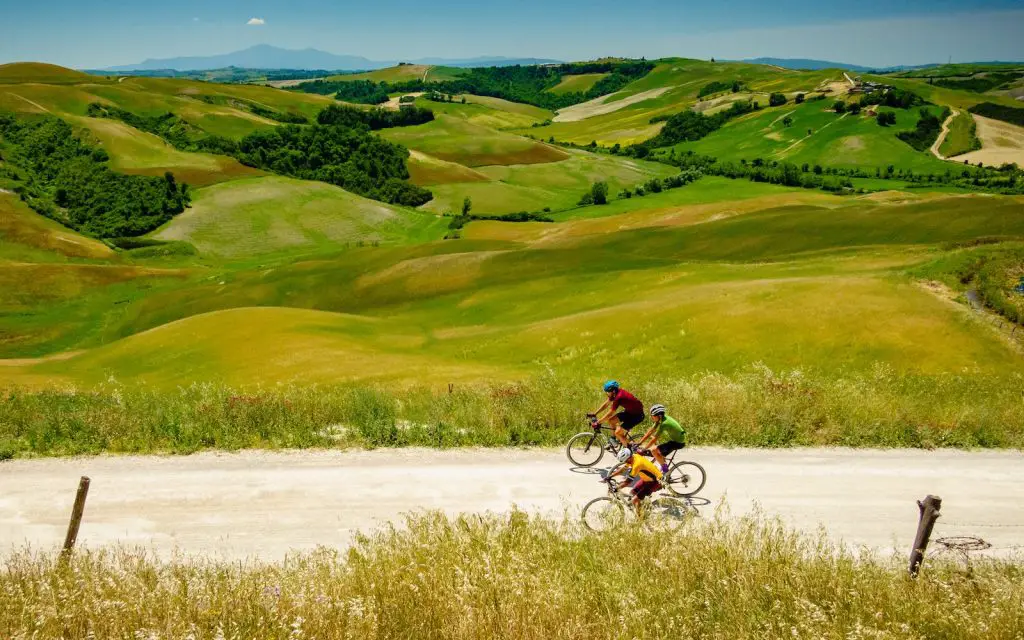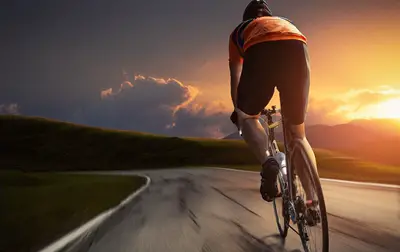Written by: As5791

Riding a bike is an endeavor that is somewhere between a jogging routine and paddling a kayak. The speed and distance that you will be able to cover will largely depend on your personal fitness level and the type of equipment you are using. It is a combination of a person and a simple machine that will determine how far you will go on any given day.
So, how far can you go on a bike in one day?
There are three levels to consider:
- For beginners 3-5 miles a day
- For Intermediate riders or bike tourists 20-30 miles a day
- Professionals and enthusiasts 40 miles+ a day
Factors that Determine the Distance of How Far You Can Go
Table of Contents
It is important to note that whenever you are biking, the distance covered depends on several variables. These are; your reason for biking, your current fitness level, the type of bike you are using, and the number of hours you will be biking for the day. Road conditions and the general terrain or type of landscape also come into play in the area you will be traversing.
Reasons for Riding a Bike
For reasons of safety and purpose, any beginner or even the average leisure biker will need to know how they want to ride the bike for the day. It could either be a one-off plan or something that you would like to do regularly. Aside from the practical purpose of using a bike to commute (a.k.a. riding a bike to work), advances in bicycle technology have expanded bike riding into more than an exercise or educational activity.
It has become known as bike tourism.
Popular Categories of Bike Tourism:
·Day rides or City Cycling
These are mostly spontaneous day tours of local parks and other city attractions. It could be done once or twice a week, depending on the time available. Again, this depends on the rider.
·Destination Riding
This is all about preparing and going to a certain tourist attraction while riding your bike and enjoying the scenery. (e.g., Mountain biking in Crested Butte Colorado or in Park City, Utah.)
·Bicycle Travel
Biking tours that are independently organized and may be stretched over a few days. (e.g., Trail biking, overnights, adventure)
·Competition and Events Cycling
These are events that most professionals and enthusiasts participate in.
(e.g., Tour de France and other grueling competitive races that involve corporate sponsorship)
These are most of the biking reasons that you can decide on, and when you are done choosing, you may begin planning and selecting the type of equipment you will want to use. By knowing exactly what you want out of the experience, you get the most benefit and satisfaction out of this versatile and adventurous hobby. Note: it is also important to begin and end with safety in mind.
Before deciding on any place, you need to know the security and viability of your destination. You would like to have as much fun as you could without having to worry about being mugged or falling off the cliff.
Match Your Bicycle with Your Touring Goals
There are two main types of bicycles that you can select from to serve the purpose of your outing:
Road Bikes
Road bicycles have lighter frames and are equipped with tires that are smaller in diameter. They are built for speed and work well on flat or paved asphalt and cement roads. Thinner tires mean less contact, and less contact means less friction, leading to more speed with less effort. You can go on an average of 10-13 mph on road bikes.
Mountain Bikes
MB’s are built to be more durable to withstand rough terrain and off-road conditions. They are slightly heavier than road bikes, and the wheels are made to be bigger in diameter for better grip and stability when going on trails. Expect your distance to be limited by the steep inclines and other ground conditions that affect your speed as well.
Expect your speed to be at an average of 10 mph on level terrain compared to an 8mph incline up a hill or mountain. You can also go as fast as 16-18 mph going downhill. Your daily average distance on a mountain bike will significantly differ depending on the terrain.
How Much Time Can You Spend Biking?
Distance will also depend on how much time you are willing to spend biking for the day. You will want to plan your hours since; obviously, you won’t be able to bike the entire day without rest. For a beginner, you may start 30 minutes a day, while the intermediate level can spend an average of 3-5 hours a day. Once you’ve established a regular time frame, you may start building your route, destination, and mileage all-around your regular time schedule.
More time spent means more mileage.
Do you Plan to Ride Solo, Or Are You Biking with Friends?
Biking solo in of itself is as exhilarating as being free and feeling that soft wind on your face as you accelerate. You’d be surprised at how much more fun you will have if you go with friends or family. While riding as a group is enjoyable in itself, it comes with its own limitations. You will have to stick with the group, and you can only go as far as your biking companions would be willing to go.
On the other hand, if you go solo, you can always stretch yourself as far as your personal limits will allow you.
The Weather and Current Road Conditions
Plan your route according to bike rideability in your target location. Whether it’s an off-state destination or just in your neighborhood, always consider road conditions before going out. Is the road bumpy? Is it always raining where you live? Are the roads often wet?
Wet roads can be dangerous for any two-wheeled transport, with or without an engine. We recommend only biking when necessary on wet slippery roads. And altogether, avoid it when it’s raining.
Are you biking in a large area of flatlands? Or is it a steep and winding ascent and descent in and around hills? Is the pavement well maintained, or is it muddy and full of holes? These conditions will significantly affect how far you can go in one day.
So, remember, even if you have the most advanced bike available and you are a supreme athlete, road conditions are a major factor in how far you can go. Map out your route, then ride for three consecutive days on your allowable time per day, and the resulting average will be your distance per day.
Our Recommendations
Practice
Assuming that you are a beginner or intermediate biker, you may start with a 3 to 5-mile bike practice cruising at 10 to 13 mph per day. Gradually increase the distance of a few miles per week, or as preferred. Keep your body in good condition by eating well and getting adequate rest. Always have drinking water available during the ride, and remember to keep yourself hydrated.
Make Plans and Set Goals for Yourself
Once you have acclimated to the outdoors and have established a regular rhythm during practice, it is now time to plan your tour. This could mean just in and around the backwoods of your city-state or in some other scenic spot in the country. The choice is yours.
Start within the range of 20-40 miles per day as an average, and keep in mind that you are only in competition with yourself. Pushing yourself too hard to go farther the next day every day might cause you to become frustrated and quit. Focus on getting a great workout, enjoying the scenery, and looking out for yourself while on the road. Concentrate on getting that full bike touring experience.
Sky’s the Limit
One good thing about going on a biking adventure is your will to go the distance. There is no limit to how far you can go for the day, provided conditions permitting, such as passable roads and good weather. What is important is you get the full benefit of cycling while reaching your goals. You can always go for an increase in mileage twice a week, weekly, or even monthly.
Take Breaks
Riding for long periods of time without taking any breaks can cause fatigue that might lead you to stop riding altogether. Take time to stop by the side of the road and drink from your water bottle. Or maybe eat a light snack in a café while you are resting. This is to help you pace yourself while taking those small steps to achieving your goal.
Take a Rest Day
Like most self-supported tours, you can decide how many rest days you can have per week. You may go for one or two days, maybe even three depending on your current physical condition and your progress vs. your goal. If you want to enjoy yourself and take it slow, you may go for one rest day a week accordingly.
What to Avoid
Try not to rush into covering long distances in a short amount of time. Make it a point to impress yourself instead of other people about your biking prowess. It is a better motivation against the real possibility of burning out because of frustration. Start leisurely and build up your progress according to your capacity.
Ride safe and enjoy!

